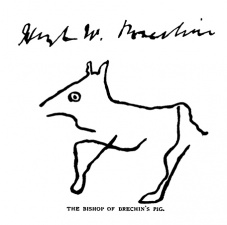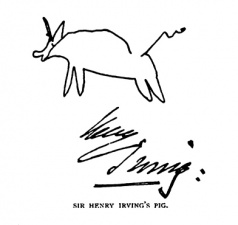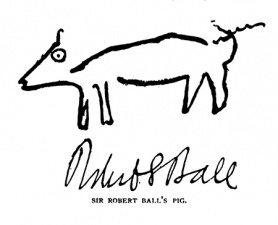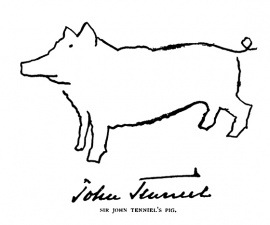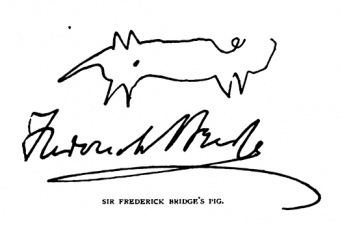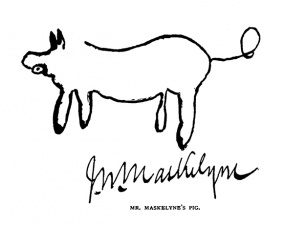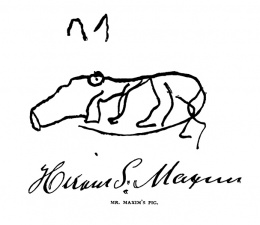Pigs of Celebrities
Pigs of Celebrities is an article written by Gertrude Bacon published in The Strand Magazine in march 1899.
Gertrude Bacon asked several celebrities, including Arthur Conan Doyle, to draw a pig, blindfolded, and she analysed the result. For the Conan Doyle's pig she gave the following analysis:
- « Turning to the "pig literary," he must be wanting in imagination indeed who fails to trace in Dr. Conan Doyle's spirited little sketch the resemblance to the immortal and lamented Sherlock Holmes. That pig is evidently "on the scent" of some baffling mystery. Note the quick and penetrating snout, the alert ears, thrown back in the act of listening, the nervous, sensitive tail, and the expectant, eager attitude. The spirit of the great detective breathes in every line and animates the whole. »
Illustrations
-
Lord Robert's pig.
-
Sir Francis Jeune's pig.
-
Lady Jeune's pig.
-
Professor Ramsay's pig.
-
The Bishop of Brechin's pig.
-
Sir Henry Irving's pig.
-
Sir Robert Ball's pig.
-
Sir John Tenniel's pig.
-
Dr. Conan Doyle's pig.
-
Sir Walter Besant's pig.
-
Sir Frederick Bridge's pig.
-
Mr. Maskelyne's pig.
-
Mr. Maxim's pig.
Pigs of Celebrities





Here is ever a fascination in collections, and ours is, perhaps, a more essentially collecting age than any other. We collect all the things that our forefathers used to — pictures, books, plate, and other articles of vertu; and we have added to them a number of quite new ideas of our own — stamps, post-cards, railway-tickets, buttons, and what not, whose chief value would appear to lie in their strange character and utter uselessness.
But now, as always, the palm of collections is universally accorded to those of personal relics of the great, and the fact that these are hard to come by only enhances their value ; which value too is immensely increased on the death of the original owners. Very often indeed it is then only that they acquire any worth at all. For example, Lord Nelson's coat may now be well-nigh priceless, may form a worthy gift to the Sovereign herself; while the coats that the great sailor gave away during his lifetime descended to the rag-man in natural course, as those of his humblest lieutenant. This is one of the difficulties in the way of those who would fain form collections .of mementos of yet living celebrities, and to the great majority of these, as in past days, the only course open is autograph-hunting.
Autographs possess certainly a very great advantage over many other souvenirs. They are lasting, they are portable, and they are eminently characteristic, which is more than can be said of snuff-boxes and old clothes. They, moreover, lie more or less within the reach of those whose worldly means may not be great, but who possess a fair amount of perseverance and self-assurance. The name of these is legion, as every celebrity knows only to his cost, and we may well believe that the information regarding autograph-hunters, which might be supplied by distinguished people, would be not only extremely interesting, but also somewhat startling in its nature.
Of course, there are various species of autograph collections. There is the autographed book, with "the author's compliments" on the fly-leaf. This is particularly attractive and valuable, and not to be lightly come by ; but then all geniuses are not literary men, any more than all literary men are geniuses. There is likewise the auto-graphed photograph, most delightful form of all, for besides perpetuating the face as well as the handwriting, its possession usually indicates a certain amount of personal friendship between giver and receiver. The following pages are intended to show yet another variety that the collection may assume, and which, among other advantages, may, at least, claim for itself a share of novelty and originality.
It consists, in short, of a number of drawings of that familiar animal the pig, drawn with the eyes shut, by leading representatives of science, art, literature, society, etc., whose world-wide renown is only equalled by their ready kindness and courtesy in ministering to the pleasure and benefit of those around them, and their exceeding indulgence in yielding to an audacious request. The idea, of course, originates in the old drawing-room game, though as a bonâ-fide collection is less often seen than its obvious advantages would seem to warrant.
Carlyle says that, given a hero, or in other words a genius, it is only a question of his environment whether he will develop "into a poet, prophet, King, priest, or what you will." The vital spark is there, and will assert itself, no matter into what lines it falls. In a similar manner, granted a man of genius and strong personality, then every-thing about him and every action, however slight, he performs will bear the unmistakable imprint of his great characteristic. It is no hard task to read a man's character in his face, but, as has been before exemplified in these pages, it is equally possible to do so from his hands and ears. To those who make a study of calligraphy it seems that the handwriting affords an index to character to be almost implicitly relied on, and to these students, as well as in a lesser degree the casual observer, a glance at the drawings which accompany these words will, I think, sufficiently satisfy them that, in an almost greater degree, the blindfold pigs exemplify the teaching of the autographs below.
Take the first specimen for example, which Lord Roberts so graciously consented to draw for this article. Is it possible to conceive an animal more endowed with the martial spirit of its noble artist? It is essentially and above all a fighting pig. Note the firmly planted feet, the aggressively forward sloping ears, the quick eye, the stubborn, determined face, and pugnacious tail. The whole attitude is instinct with pluck and defiance. This animal is "game" to the last; he has also undoubtedly "got his back up." That Lord Roberts has paid particular and unusual attention to the "trotters" indicates a careful and observant eye, a keen sense of what is right and fitting, and an untiring attention to details, while the fact that he has consented to draw a pig at all is only another proof that, besides one of the bravest, he is likewise among the most courteous of men.
Equally distinctive is the pig of Sir Francis Jeune. Its judicial characteristics are apparent to all, even without the aid of the familiar initials beneath. It is in all respects a "carefully balanced" animal, and there is no mistaking the shrewdness and penetration of the eye. There is no wandering from the point, no unnecessary digressions and flourishes. The very gait suggests the even course of justice, not prone to jump to rash conclusions, not to be unduly hastened, but with patient and cautious footsteps progressing slowly and surely and impartially to the goal of equity and truth.
The companion drawing is by the famous judge's equally famous wife. Those among Lady Jeune's admirers (and who are they who do not reckon themselves in that great army?) will welcome its presence as a fresh instance of her ladyship's never-failing kindness and graciousness ; while recognising in it indications of those social and intellectual gifts that render her alike the model hostess, the leader of society, the greatest authority on every branch of women's life and work, and the prime mover in every good scheme for the amelioration and benefit of her poorer neighbours. A peculiarity about this animal, shared only by Professor Ramsay's, is that it turns its head to the right, the reverse position to that naturally given to a pig when drawn with the right hand.
The kindness of the Bishop of Brechin in allowing his pig to adorn these pages will be appreciated by all. The popular and revered Primus of Scotland displays in his drawing those kindly and genial traits which have endeared him to all throughout an active and varied career. Turn we now to the " pig scientific," luckily represented in the two great branches of Astronomy and Chemistry, by Sir Robert Ball and Professor Ramsay. The renowned astronomer, author, lecturer, and most genial of men draws us a pig, in which he himself would be the first to trace its Irish antecedents. The keen eye of the star-gazer is there, and the fine, tapering snout that indicates the man of letters. Sir Robert seems to have forgotten the ears, as, too, oddly enough, has Sir Francis Jeune, a curious omission in his case, for if justice be blind it is certainly not deaf.
The extreme excellence of Professor Ramsay's pig leads one almost to the suspicion that the great chemist had a corner of one eye open when he drew it, or else possessed a Röntgen-ray-like power of seeing through closed lids ; but in this I may be doing him injustice. That his animal possesses a most fascinating personality no one will deny. There are indications of extreme modesty about the lowered head, downward sloping ears, and half-shut eye, while a capacity for taking infinite pains, minute attention to details, and the power of laborious research is as plainly evident in the talented little sketch as in the famous discoverer of Argon, Krypton, and the other rare constituents of the atmosphere himself.
Again, in the "pig histrionic" what can be more apparent than the tragic tendency it has unconsciously received from the hand of the greatest of tragedians? Sir Henry Irving has instilled a pathos and despair into the expression of his pig that the jocund and light-hearted animal can scarcely display in real life. But to Sir Henry himself it is the tail that appeals most. "It may be vanity," he writes, "but I cannot help regarding it as a masterpiece," and in this opinion admiring and grateful beholders will readily acquiesce.
An unfortunate diffidence has robbed this article of another famous actor's pig, Mr. Wyndham writing in response to an appeal that he "cannot draw with his eyes open, let alone if they were closed." Sir Evelyn Wood too replied in almost the same words. These gentlemen unfortunately did not know that the less capable you are of drawing a pig with eyes open the better one you will probably produce with eyes shut. An ardent collector will never accept as an excuse an alleged incapacity for drawing. Very frequently the objector possesses a latent talent which he either conceals from modesty or else is unconscious of; and in any case the chances are that he will produce an animal that will surprise him very much by its excellence.
Certain it is that, the better a man draws, the harder work it is to coax a pig out of him. To get a blindfold pig from a celebrated artist is rare indeed, and I doubt whether an R.A. has ever been known to draw one. We may feel the more grateful, then, to that famous veteran, Sir John Tenniel, for his unexampled goodness in giving us a specimen from his own unrivalled pencil. It is the work of an artist, indeed, and even Sir John himself seems rather proud of it; for he writes "I have much pleasure in sending you my picture of a 'Piggee,' drawn in pencil (blindfold), and duly signed. The result, as I need hardly say, fills me with wonder and admiration. It is simply an amazing fluke." He further adds that he will never attempt another, but we will venture to disagree with him as to the fluke, believing that whatever comes from that deft pen will inevitably be the best possible.
Turning to the "pig literary," he must be wanting in imagination indeed who fails to trace in Dr. Conan Doyle's spirited little sketch the resemblance to the immortal and lamented Sherlock Holmes. That pig is evidently "on the scent" of some baffling mystery. Note the quick and penetrating snout, the alert ears, thrown back in the act of listening, the nervous, sensitive tail, and the expectant, eager attitude. The spirit of the great detective breathes in every line and animates the whole.
Nor is the indication of patient and deep research, literary skill, and subtle imagination less apparent in the animal Sir Walter Besant has favoured us with. The absence of the second ear is, doubtless, to be accounted for by its being directly behind the other.
On the contrary, the cars drawn by Sir Frederick Bridge are both well defined. This, of course, is only what would be looked for in the animal of a composer. Note the deep-set eye. That in a human being is generally considered a mark of a mathematical mind, and music and mathematics are proverbially associated. The gait of this pig, too, is undoubtedly "andante."
In the "pigs mechanical" we have been lucky, indeed, in securing the work of two such mighty masters of their art as Mr. Maxim and Mr. Maskelyne. What two greater triumphs of human ingenuity can we find than the Maxim gun and the "Box trick"? Both are mechanical problems, for which either mechanician may well envy the other, while the ordinary intellect stands amazed before such inventive genius.
Referring to his pig, Mr. Maxim writes "I have just a suspicion that the pigs that are so well drawn in your album are by people who had their eyes partly open. The trouble with my pig is that my eyes were too tightly closed." But nobody will find fault with Mr. Maxim's animal on this score or on any other. It bears the imprint of his matchless genius, and is certainly suggestive of the action of his incomparable gun.
That Mr. Maskelyne had the box trick in his mind when he drew his shapely pig is evident from the resemblance it bears to the incomprehensible creature known generally as the "monkey," but sometimes credited with being something more, that emerges from that unfathomed mystery. The animal otherwise is eminently characteristic of one of the most ingenious, genial, and generous of men.
We have also received a remarkably good pig from Mr. Harry Furniss, together with a most interesting letter in which Mr. Furniss reveals a secret of his own for drawing pigs blindfold almost as well as when the eyes are open. As we do not wish to give away this secret before our readers have had an opportunity of trying what they can do in the ordinary way, we reserve Mr. Furniss's letter and drawings for publication next month.




